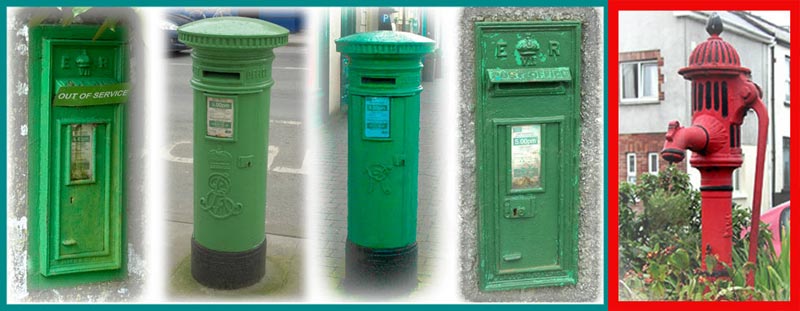
Before we discuss what Street Furniture has mysteriously vanished, let us discuss for a moment what, today at least, currently exists.
We pass them every day giving them little recognition; but very soon the Irish Post Box is likely to become obsolete. Indeed, were it not for that essential correspondence each November with Father Christmas and our insistence on sending other miscellaneous thingamajigs, such as invitations, Christmas cards; this service would have vanished altogether.
Walled Post boxes and Post Pillar Boxes, where they currently exist in Thurles today, remain the once symbol of a more autonomous order, which demanded at all levels, high standards. With education being encouraged during Victorian times, communication, through the writing of letters was being identified as essential. Children were being encouraged to attend schools, except of course during peak harvest times, when family run farms saw crop saving as taking precedence; deemed more necessary to the needs of family preservation, than education.
Browse in any well stocked Irish tourist shop, which sells greeting cards, and you will most likely find a postcard featuring a green post box. Check same on any real street-scape scene today however, and you will find such collection boxes in an extremely neglected state, many gagged with “Out Of Service” signs, (See picture one above). The changeover, by modern society, to mobile phone text messaging and emailing have seen the news filled, multiple page, hand written, letter to the family, become almost as extinct as the white Rhino.
Irish Post boxes erected before 1922 usually carry the insignia, or cipher, of the reigning British monarch, dating the time of is initial placement. The vast majority of such postal collecting boxes arrived here in Thurles during the reign of Edward VII, (1901 until his death in 1910).
The oldest free-standing cast-iron pillar box in use in Thurles, (c. 1879), today sits on the south side of Friar Street, placed there during the reign of Queen Victoria (1819 -1901). Same is identified by the National Inventory of Architectural Heritage as being an interesting example of good quality street furniture, with high-quality design and execution.
Óige Sinn Féin opposed to British symbols on post boxes in Northern Ireland believing that they could fight oppression and bring about a united Ireland by painting the red post boxes in a Republican green. Behaving rather like Islamic State (ISIS) followers in Syria and then in Iraq, they also, in a much more minor way of course, began the destruction of their heritage, attacking unsuspecting pillar boxes, foolishly believing that a two-inch paint brush, would strike terror and thus the deciding blow in attaining a united Ireland.
Alas, no one had informed their leadership that when these red postal pillar boxes were first introduced, most of same had been painted a dark green. It wasn’t until 1874 that the British Post Office had decided to paint them Royal Red, in an effort to ensure that they could be recognised more easily, by letter writers. With the arrival of Irish Independence, the Irish Post Office changed the colour red back to green here in our new Irish Republic.
Interesting to note; when a postal surveyors job came up in central Ireland in 1841, the position was quickly filled by the renowned British novelist Anthony Trollope, (1815-1882). Trollope was based initially in Banagher, King’s County, (Co Offaly), just 10 miles from the Tipperary border, with his work consisting largely of inspection tours in the province of Connaught. Trollope remained stationed at Banagher until late 1844, when he was transferred to Clonmel, here in Co. Tipperary; living at Briarview House, Marlfield, just a couple of miles west of Clonmel town. It is he whom today we credit with the introduction of the Irish pillar box.
Missing Thurles Street Furniture.
It is described in the National Inventory of Architectural Heritage as a Cast-iron Water Pump, set on a platform with Stone Trough. It had a banded shaft and curved handle with fluted neck and fluted cap with pineapple finial. It had a foliate decoration where the spout met the neck.
The inventory goes on to say, “This water pump has an unusually comprehensive repertoire of artistic detailing, including banding, fluting, and foliate decoration to the spout. The pump is located at the junction of three streets, a typically busy location for a water source for the community. While no longer in use today, it still makes a positive contribution to the street-scape”.
What it wrongly stated is that it was erected c.1870; factually it was erected in the late 1980’s by the late Mr Wilbert Houben, Mr Joe O’Regan and myself, when we were members of Thurles Tidy Towns. I personally purchased the cut stone trough and pump, referred to in this National Inventory of Architectural Heritage; the trough from Auctioneer Mr John Gleeson who located it at my request.
The water pump and cut stone trough were removed a few years back, with the knowledge of Tipperary County Council & Thurles Urban District engineers, who stated that same would be returned, following the installation of the Cathedral Street Roundabout. This Street Furniture, consisting of the donated water pump and cut stone trough, were never returned and I would love to know would the National Inventory of Architectural Heritage be able to confirm their current whereabouts.
Maybe our elected Municipal District Public Representatives, (all committed, as one would expect, to developing a strong sense of pride in our Thurles community), their fellow committed County Engineers and District Administrators, would stick their heads outside the door, to let a yell down the yard, so as to enquire into who might have seen them last.

VERY SAD